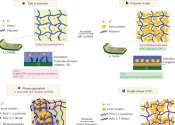Study suggests solar energy can be cleanly converted into storable hydrogen fuel
Research led by the University of Strathclyde suggests that solar energy can be accessed and converted into hydrogen—a clean and renewable fuel.
May 5, 2022
8
117
Energy & Green Tech

Research led by the University of Strathclyde suggests that solar energy can be accessed and converted into hydrogen—a clean and renewable fuel.
May 5, 2022
8
117
Engineering

Engineers have designed and successfully tested a more efficient wind sensor for use on drones, balloons and other autonomous aircraft.
Aug 8, 2022
0
154
Engineering

A team of researchers from Georgia Institute of Technology and two other institutions has developed a new 3-D printing method to create objects that can permanently transform into a range of different shapes in response to ...
Apr 12, 2017
0
621
Electronics & Semiconductors

Solar cells will doubtless play a significant part in a sustainable energy future. Polymer solar cells (PSCs) specifically provide an excellent option because they are cheap to produce and can be both flexible and semitransparent. ...
Apr 21, 2022
0
1073
Energy & Green Tech

Solar cells have great potential as a source of clean electrical energy, but so far they have not been cheap, light, and flexible enough for widespread use. Now a team of researchers led by Tandon Associate Professor André ...
Mar 5, 2018
0
173
Electronics & Semiconductors

For decades, field-effect transistors enabled by silicon-based semiconductors have powered the electronics revolution. But in recent years, manufacturers have come up against hard physical limits to further size reductions ...
Jun 23, 2022
0
262
Electronics & Semiconductors

Like the brakes that stop cars, a molecular brake exists that can prevent semiconductor chains from slipping, enabling the creation of more groundbreaking devices.
Jun 9, 2023
0
133
Energy & Green Tech

Lithium-metal batteries, which contain anodes based on metallic lithium, are promising rechargeable batteries that could help to meet the growing demands of the electronics industry. These batteries have various advantages, ...
Engineering

In just 30 seconds, a devastating earthquake like the ones that struck Japan and Ecuador can render a city helpless. With roadways split and bridges severely damaged, residents and emergency personnel could be prevented from ...
Apr 28, 2016
0
376
Energy & Green Tech

Imperial researchers are designing cheaper and more flexible solar energy materials, set to rival traditional rigid silicon panels.
Jan 12, 2017
2
25
A polymer (from Greek πολύ-ς /po΄li-s/ much, many and μέρος /΄meros/ part) is a large molecule (macromolecule) composed of repeating structural units typically connected by covalent chemical bonds. While polymer in popular usage suggests plastic, the term actually refers to a large class of natural and synthetic materials with a variety of properties.
Due to the extraordinary range of properties accessible in polymeric materials , they have come to play an essential and ubiquitous role in everyday life - from plastics and elastomers on the one hand to natural biopolymers such as DNA and proteins that are essential for life on the other. A simple example is polyethylene, whose repeating unit is based on ethylene (IUPAC name ethene) monomer. Most commonly, as in this example, the continuously linked backbone of a polymer consists mainly of carbon atoms. However, other structures do exist; for example, elements such as silicon form familiar materials such as silicones, examples being silly putty and waterproof plumbing sealant. The backbone of DNA is in fact based on a phosphodiester bond, and repeating units of polysaccharides (e.g. cellulose) are joined together by glycosidic bonds via oxygen atoms.
Natural polymeric materials such as shellac, amber, and natural rubber have been in use for centuries. Biopolymers such as proteins and nucleic acids play crucial roles in biological processes. A variety of other natural polymers exist, such as cellulose, which is the main constituent of wood and paper.
The list of synthetic polymers includes synthetic rubber, Bakelite, neoprene, nylon, PVC, polystyrene, polyacrylonitrile, PVB, silicone, and many more.
Polymers are studied in the fields of polymer chemistry, polymer physics, and polymer science.
This text uses material from Wikipedia, licensed under CC BY-SA